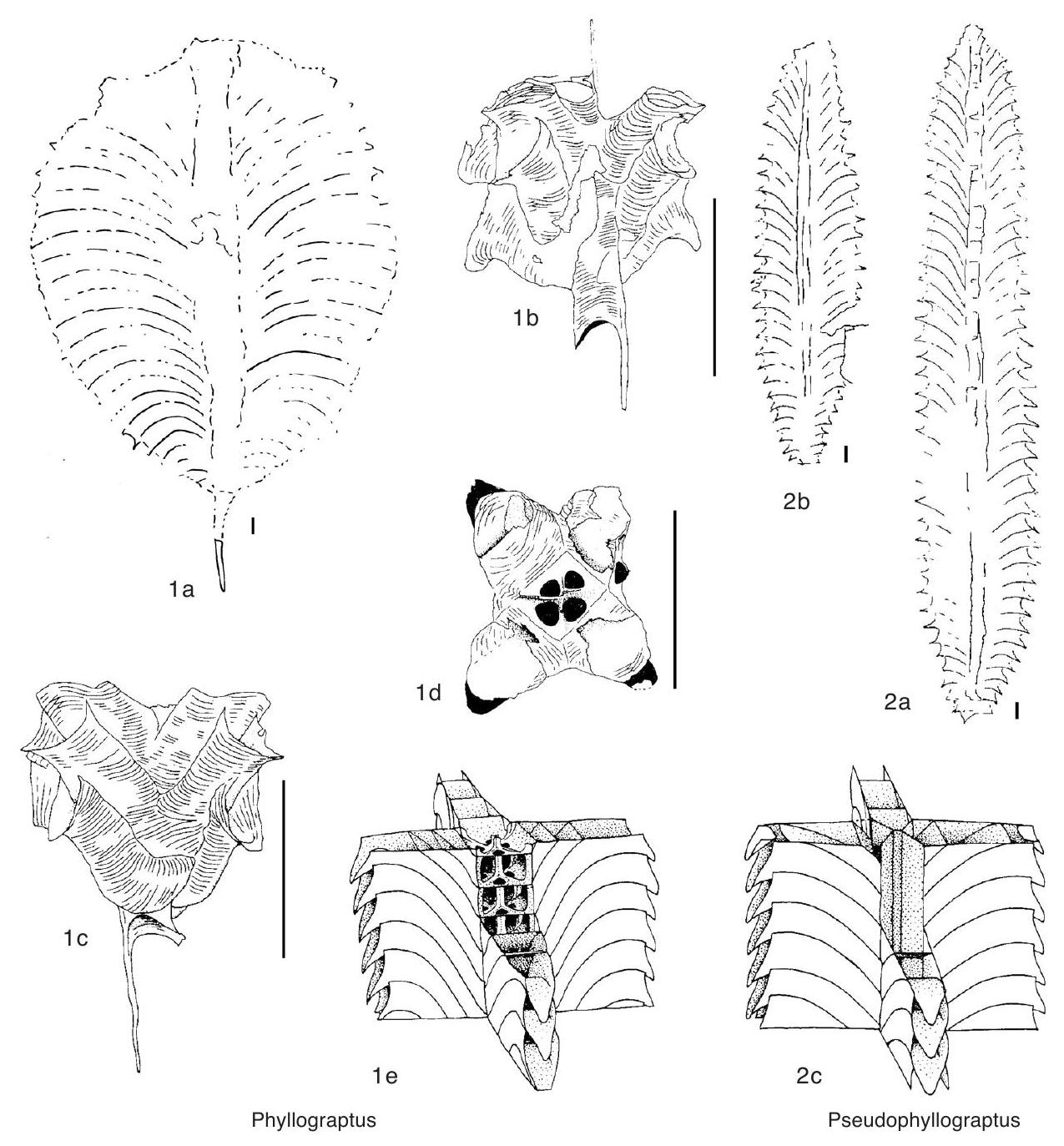Welcome to the Treatise on Invertebrate Paleontology!
Please enter a genera name to retrieve more information.

Phyllograptus
Classification
Phylum:
Hemichordata
Class:
Pterobranchia
Subclass:
Graptolithina
Order:
Graptoloidea
Suborder:
Dichograptina
Family:
Phyllograptidae
Formal Genus Name and Reference:
Phyllograptus HALL, 1858, p. 137
Type Species:
*P. typus, OD
Images
(Click to enlarge in a new window)
Fig. 192,1a-e. * P. typus, la, lectotype, GSC 942b, ?G-locality, Lévis, Quebec, Canada, 1 b-c, PMO NF 3312, PMO NF 3314, isolated material in obverse (b) and reverse (c) views, 1d, PMO NF3314, distal view of isolated fragment showing interthecal foramina, 1 e, reconstruction to show central columella, 1 b-d, Spitsbergen, Norway, scale bars, 1 mm (Cooper & Fortey, 1982, fig. 67a-b, 71, 71k, and 74, respectively)
Synonyms
Geographic Distribution
Canada, USA, Australia, New Zealand, Argentina, China
Age Range
Beginning Stage in Treatise Usage:
Lower Ordovician (Floian, Tshallograptus fruticosus Biozone)
Beginning International Stage:
Floian
Fraction Up In Beginning Stage:
0
Beginning Date:
477.08
Ending Stage in Treatise Usage:
Middle Ordovician (Dapingian, Isograptus victoriae Biozone)
Ending International Stage:
Dapingian
Fraction Up In Ending Stage:
100
Ending Date:
469.42
Description
Phyllograptid with four stipes united along dorsal margins, producing cruciform cross section, median septa reduced to framework of fornices and central columella with open foramen between thecae of adjacent series, sicula with dorsal virgellar spine, often strongly elongated and thickened, proximal development isograptid, dextral, thecae continuing to grow and elongate as tubarium itself continues to grow
References
Hall, James. 1858. Descriptions of Canadian Graptolites. Note upon the genus Graptolithus, and descriptions of some remarkable new forms from the shales of the Hudson River group, discovered in the investigations of the Geological Survey of Canada, under the direction of Sir W. E. Logan, F. R. S. In W. E. Logan. 1858. Report of Progress for Geological Survey of Canada. John Lovell.
Museum or Author Information
Classification
Phylum:
Hemichordata
Class:
Pterobranchia
Subclass:
Graptolithina
Order:
Graptoloidea
Suborder:
Dichograptina
Family:
Phyllograptidae
Formal Genus Name and Reference:
Phyllograptus HALL, 1858, p. 137
Type Species:
*P. typus, OD
Images
(Click to enlarge in a new window)
Fig. 192,1a-e. * P. typus, la, lectotype, GSC 942b, ?G-locality, Lévis, Quebec, Canada, 1 b-c, PMO NF 3312, PMO NF 3314, isolated material in obverse (b) and reverse (c) views, 1d, PMO NF3314, distal view of isolated fragment showing interthecal foramina, 1 e, reconstruction to show central columella, 1 b-d, Spitsbergen, Norway, scale bars, 1 mm (Cooper & Fortey, 1982, fig. 67a-b, 71, 71k, and 74, respectively)
Synonyms
Geographic Distribution
Canada, USA, Australia, New Zealand, Argentina, China
Age Range
Beginning Stage in Treatise Usage:
Lower Ordovician (Floian, Tshallograptus fruticosus Biozone)
Beginning International Stage:
Floian
Fraction Up In Beginning Stage:
0
Beginning Date:
477.08
Ending Stage in Treatise Usage:
Middle Ordovician (Dapingian, Isograptus victoriae Biozone)
Ending International Stage:
Dapingian
Fraction Up In Ending Stage:
100
Ending Date:
469.42
Description
Phyllograptid with four stipes united along dorsal margins, producing cruciform cross section, median septa reduced to framework of fornices and central columella with open foramen between thecae of adjacent series, sicula with dorsal virgellar spine, often strongly elongated and thickened, proximal development isograptid, dextral, thecae continuing to grow and elongate as tubarium itself continues to grow
References
Hall, James. 1858. Descriptions of Canadian Graptolites. Note upon the genus Graptolithus, and descriptions of some remarkable new forms from the shales of the Hudson River group, discovered in the investigations of the Geological Survey of Canada, under the direction of Sir W. E. Logan, F. R. S. In W. E. Logan. 1858. Report of Progress for Geological Survey of Canada. John Lovell.
